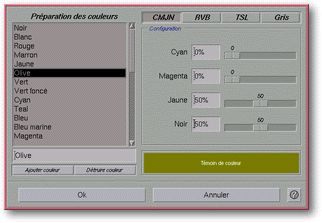![]()
![]()
This dialog box defines the colors used in Xclamation, for example, when adding color to frames or fonts. It matches color elements to color names.

Screen shot: Color dialog box
Click on the CMYK button to activate this mode. The color is then defined by the elements Cyan,
Magenta, Yellow, and Black.
Primary colors :
These primary colors are called "subtractive" because they must be removed to produce white.
CMYK chromatic mode is the one used by computer printers.
Text fields and vertical risers allow the user to set the level of a compositional element. These values demonstrate the amount of an element in a color in linear fashion. A 0% value indicates an absence of the element in the color; a value of 100% indicates the maximum possible amount of an element in the color.
When the primary colors C, M, and Y are combined, the theoretical result is black; however, when printed, the mixture of inks will produce a type of brown. To compensate for this problem when printing in four colors, the element "black" has been added. Adding 30% Black is equivalent to adding 30% Cyan + 30% Magenta + 30% Yellow.
Note: Xclamation optimises the color so that it utilises a maximum amount of pure Black; it's therefore possible that the values entered will be modified automatically when this dialog box is next displayed.
Click on the RGB button to activate this mode. The color is then defined by the elements Red,
Green and Blue.
primary colors:
These primary colors are called additives because they must be combined to produce white.
RGB chromatic mode is the one used by computer monitors.
Text fields and vertical risers allow the user to set the level of a compositional element. These values demonstrate the amount of an element in a color in linear fashion. A 0% value indicates an absence of the element in the color; a value of 100% indicates the maximum possible amount of an element in the color.
When the primary colors RGB are combined, the result is white. The absence of these colors creates black.
Click on the HSB button to activate this mode. The color is then defined by its Hue,
Saturation, and Brightness.
The common problem with CMYK and RGB modes is that they are difficult to understand intuitively. HSB mode is a more natural way of thinking about color.
Hue
Hue values are set between O and 360 degrees. They are equivalent to the values
of the color wheel, where 0 degrees is equal to 360 degrees.
The primary color values:
|
|||||||||||||||||||||
Saturation
Saturation is associated with the intensity of a color. This value is given in
the form of a percentage, from 0% (no hue present) to 100% (the hue is pure). The higher
this value, the greater the presence of a particular hue in the color being created.
Brightness
Brightness refers to the quantity of black added to a color. This value is given
in the form of a percentage, from 0% (pure black) to 100% (pure white). The higher the
level of brightness, the lighter the color. The more black present in a color (low
brightness), the darker it is.
Click on the "Gray" button to activate this mode. A color is then
defined by its percentage of white [from 0% (black) to 100% (white)]. When entering into
this mode, the selected color is transformed to gray and loses all trace of its hue.
![]()